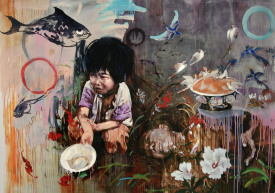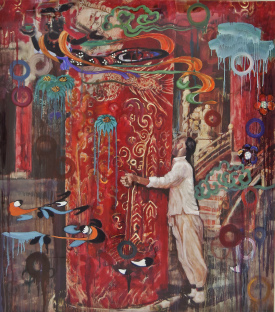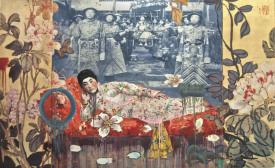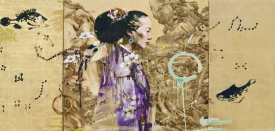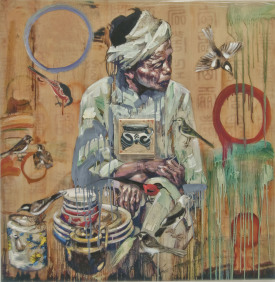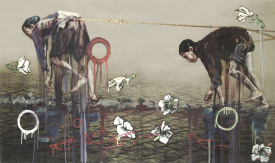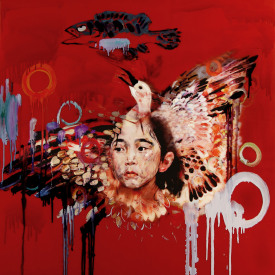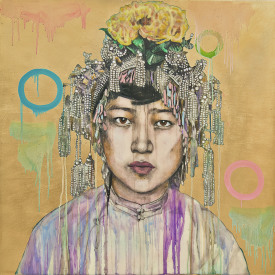Hung Liu
by Katie Hirsch
Hung Liu likes to say that she is one year older than China. Born in 1948 at the beginning of the end of the Chinese Civil War, Liu was a refugee baby. Liu’s family fled her hometown of Changchun, China, amid the terror of one of the three major battles that would lead to the establishment of the People’s Republic of China in 1949. In a sense, she has been displaced since birth. Loss of identity is one of the myriad psychological side effects of displacement. Liu’s identity underwent a seismic shift in 1984 when she left China for the United States, where she has lived ever since. For Liu, displacement amounts to drifting through the sea of your own identity with no anchor to define or calm you. When Liu considers the word “American,” she hears the term as a verb. She is Chinese but has been becoming an American every day for the last thirty-six years.
As an artist, Liu has spent much of her career focused on recontextualizing historical photographs from China. She seeks to assign identities and dignities to those whose names and faces have long been forgotten. These anonymous compatriots simultaneously honor the Chinese people and criticize the country’s tumultuous political history. In Liu’s za zhong (“bastard paintings”), the artist incorporates printmaking and painting as she recasts the photographs in order to parallel contemporary discourse. Photographs like those enlivened by Liu were often destroyed in the wake of the Cultural Revolution.
Many of the subjects of the work Liu submitted for the Dis/placements project are women. Liu found portraits of sex workers, like the reclining women in Imperial Garden and Rusalka, in a pair of books dug out of a cast-off cardboard box in a Beijing film studio. She lifted other photographs from magazines dating to the 1920s and 1930s that she found in a small school library. At the time, Liu marveled at the scenes of war and, in particular, at images of modernized Chinese women. There, covered in thick layers of dust, were photographs of women playing sports, and in shorts, no less. Liu was thunderstruck by these images of the women who had come before her, women from her mother’s time and her grandmother’s. Liu is hyper-cognizant of women’s place in history, or rather, of the empty spaces in history where women and their myriad achievements were either not recorded or, more often, unrecognized or devalued to begin with.
When asked to reflect on the concept of home, Liu turned first to the concept of identity. Is she Chinese? Is she American? Her assigned identities have ebbed and flowed over her lifetime, but her identity as a woman and mother has continuously anchored her. Liu ponders that Chinese women live and die for the men in their life: you’re a daughter; you’re a wife; you’re a mother; you’re a grandmother; you’re dead. Across generations and cultural divides, Liu feels a deep and empathetic connection to the women of the world. The paintings in Dis/placements are not just images of Chinese women, or pre-Revolutionary women, or fantasy propaganda women—they are a heartbreaking epic history of all women.
Liu’s last vital connection to China died with one such woman—her mother—who passed away in early 2011. Liu and her mother spoke on the telephone every day for the last seven to eight years of her mother’s life, sometimes for an hour, sometimes for only five minutes. Mother and daughter discussed everything from quotidian details like the price of eggplants or the goings-on of neighbors to politics and Chinese contemporary artists, literature, and cinema. With this relationship, Liu maintained an intimate relationship with China. She could smell the streets of Beijing, weigh in on local news stories, and know how her art would be interpreted in the country where she was born. With that tie severed, Liu is further displaced from her homeland, further adrift in an identity that floats between the words in the term Chinese American.
Hung Liu
Born in Changchun, China (1948)
Lives and works in Oakland, California
Hung Liu grew up in China under the Maoist regime. Initially trained in the Socialist Realist style, Liu earned her BFA at Beijing Teachers College in 1975 before studying mural painting at the Central Academy of Fine Art in Beijing, where she earned her Graduate Degree (equivalent to an MFA) in 1981. Liu immigrated to the United States in 1984 to attend the University of California, San Diego, where she earned her MFA in 1986. She is Professor Emerita at Mills College in Oakland, California. Liu’s work combines historical photographs with traditional Chinese iconography, assigning contemporary narratives and identities to historical moments.
Liu’s work has been exhibited extensively and collected by museums around the globe, including the San Francisco Museum of Modern Art, CA; Asian Art Museum of San Francisco, CA; Los Angeles County Museum, CA; Whitney Museum of American Art, New York, NY; Metropolitan Museum of Art, New York, NY; and National Gallery of Art, Washington, D.C. She has received such honors as two Painting Fellowships from the National Endowment for the Arts (1989 and 1991), and the Joan Mitchell Foundation Painters & Sculptors Grant (1998), among many others.
Hung Liu’s work was featured at the Halsey Institute in 1998 in WashingTown Blues.
Katie Hirsch
Katie Hirsch is Curator and Director of Strategic Partnerships at the Halsey Institute of Contemporary Art at the College of Charleston School of the Arts. She has organized exhibitions featuring the work of Roberto Diago, Anthony Dominguez, Coulter Fussell, and the group photography exhibition Southbound: Photographs of and about the New South, which involved fifty-six artists and for which she contributed to the catalogue.
Hirsch’s diverse arts background has informed her interdisciplinary approach to the study and exhibition of art and material culture. As a graduate student at The Florida State University, Hirsch specialized in the study of the art and culture of the Ancient Maya. Hirsch’s professional path took a turn when she moved to Shanghai, China. There, she served as Senior Curator of island6 Arts Center, a contemporary art gallery. She earned her MA in Art History at The Florida State University in 2010.


